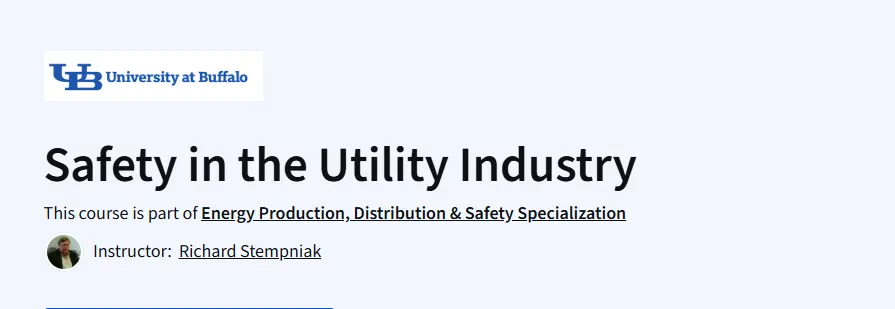What will you learn in Safety in the Utility Industry Course
Understand what safety culture means in the context of the utility industry.
Identify behaviors, systems, and attitudes that promote safety in high-risk environments.
Learn how to evaluate, improve, and lead safety programs effectively.
Gain insights into the role of leadership, employee engagement, and reporting systems in enhancing safety.
Program Overview
Module 1: Safety Culture Foundations
⏱️ 1 week
Topics: Definitions of safety culture, its impact, and key elements.
Hands-on: Real-world case studies highlighting unsafe practices and improvements.
Module 2: Building Organizational Commitment
⏱️ 1 week
Topics: Role of leadership, communication strategies, and accountability.
Hands-on: Leadership self-assessment for fostering safety values.
Module 3: Behavior-Based Safety Practices
⏱️ 1 week
Topics: Human error, peer-to-peer safety checks, behavioral change techniques.
Hands-on: Practical exercises to recognize and report at-risk behaviors.
Module 4: Incident Analysis and Reporting Culture
⏱️ 1 week
Topics: Near-miss reporting, root cause analysis, continuous learning.
Hands-on: Walkthrough of an incident investigation and safety data interpretation.
Module 5: Sustaining and Improving Safety Culture
⏱️ 1 week
Topics: Long-term safety planning, feedback loops, performance metrics.
Hands-on: Final project for creating a basic safety culture improvement plan.
Get certificate
Job Outlook
High relevance in utility, construction, energy, and manufacturing sectors.
Roles include safety officer, EHS coordinator, utility supervisor, and operations manager.
Safety culture knowledge is increasingly valued for leadership roles and compliance.
Growth in demand for safety and risk management professionals as regulations tighten globally.
Specification: Safety in the Utility Industry
|
FAQs
- Principles of safety culture apply across industries.
- Lessons can be adapted for manufacturing, construction, or logistics.
- Core focus remains utility-specific risks and behaviors.
- Non-utility learners will still gain valuable leadership skills.
- Best suited for professionals in high-risk work environments.
- Provides strong knowledge foundation for compliance roles.
- Not a substitute for OSHA, NEBOSH, or ISO certifications.
- Can enhance preparation for formal safety audits.
- Teaches how to build reporting and safety systems.
- Improves leadership credibility in compliance discussions.
- Strengthens understanding of safety culture leadership.
- Valuable for safety officer, supervisor, and EHS roles.
- Demonstrates commitment to workplace safety.
- Provides real-world examples employers appreciate.
- Enhances profile for promotions or cross-industry shifts.
- Includes case studies of unsafe practices and improvements.
- Offers practical exercises on reporting and behavior checks.
- Final project focuses on safety culture improvement planning.
- Designed to link theory directly with field application.
- Encourages reflection through leadership self-assessments.
- Focuses on “culture” rather than only rules and procedures.
- Explains leadership, communication, and accountability in safety.
- Uses a behavior-based approach to reduce risks.
- Encourages proactive reporting and analysis of near misses.
- Goes beyond compliance to create sustainable safety mindsets.





